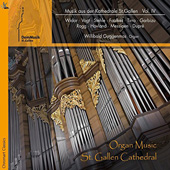
COLLECTIONS

Charles Marie Widor (1844-1937) - Hymne héroïque
Jacques Vogt (1810-1869) - Fantaisie-Orage
Johann Gustav Eduard Stehle (1839-1915) - Fantasie über ein Kirchenlied Op. 70/4
William Faulkes (1863-1933) - Légende et Final
Frank Tirro (b.1935) - Echoes: Parce Domine
Tomás Garbizu (1901-1989) - Toccata sobre un tema gregoriano
Tomás Garbizu (1901-1989) - Sequentia sobre Victimae Paschali
Lionel Rogg (b.1936) - Vision apocalyptique La Cité Céleste
Egil Hovland (1924-2015) - Lux Aeterna Op. 135/3
Olivier Messiaen (1908-1992) - VI Epiphanie from: Méditations sur le Mystère de la Sainte Trinité
Marcel Dupré (1886-1971) - Regina Coeli Op. 64
Marcel Dupré (1886-1971) - Poème héroïque Op. 33
The 1968, four manual, 5465 pipes, 74 stops Kuhn AG pipe organ that sits in St. Gallen Cathedral, Switzerland, is an impressive instrument that was built and designed with versatility in mind, as it can comfortably recreate music ranging from Sweelinck to Messiaen. Organist Willibald Guggenmos has definitely chosen a varied program here that not only demonstrates the organ's capabilities, but also covers a wide array of musical styles, spanning over 200 years, from American, Spanish, Norwegian, British, French and Swiss composers.
The highly melodic and cantabile style of the Légende by William Faulkes brings out this instruments beautiful foundation, reed and flute stops, well balanced by Willibald Guggenmos, while the Hymne héroïque by Charles Marie Widor certainly captures this organ's brilliant power in 'plein-jeux'. Another piece that highlights this instrument's subtleties is Egil Hovland's evocative Lux Aeterna, as well as the slightly blues tinged Parce Domine by American composer Frank Tirro, again perfectly registered by Guggenmos. And I was also highly impressed by the music of Tomás Garbizu.
But the composition that deserves special mention, is the Fantaisie-Orage by Swiss organist Jacques Vogt. Just like Beethoven's Symphony No. 6, it attempts to portray the effects of a thunderstorm in the countryside. From the bucolic, idyllic setting of nature, to the alerting shepherd warning calls, to the violent storm itself and the praiseful joy of the population in its aftermath, every aspect of this work is highly musical, despite the use of entire palms and elbows needed to emulate the lightning strikes and thunderclaps. It brings out this organ's full glory. Play it loud and run for cover!
Below is a short video of organist Willibald Guggenmos demonstrating this instrument's qualities.
Jean-Yves Duperron - June 2018